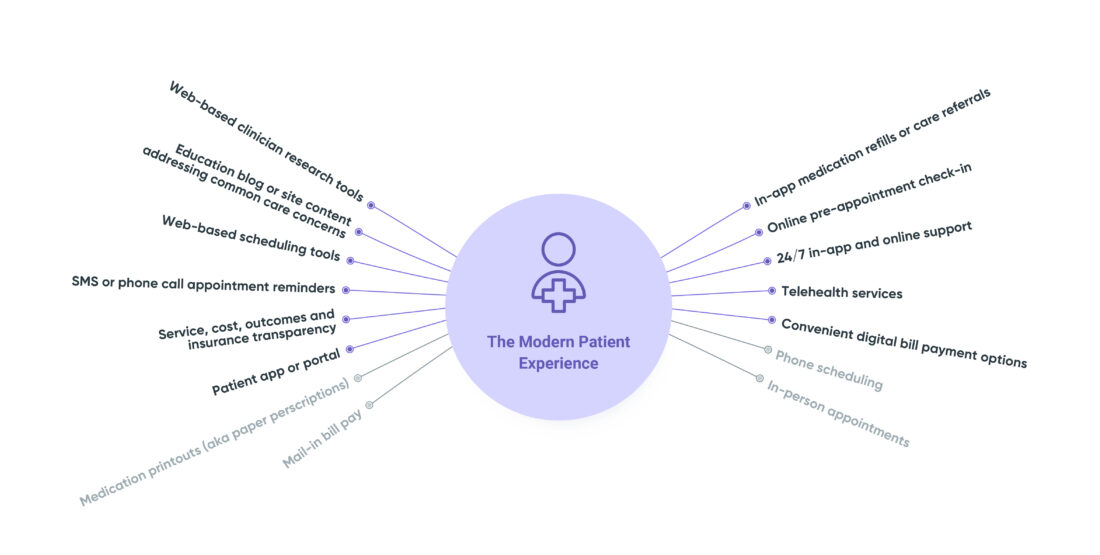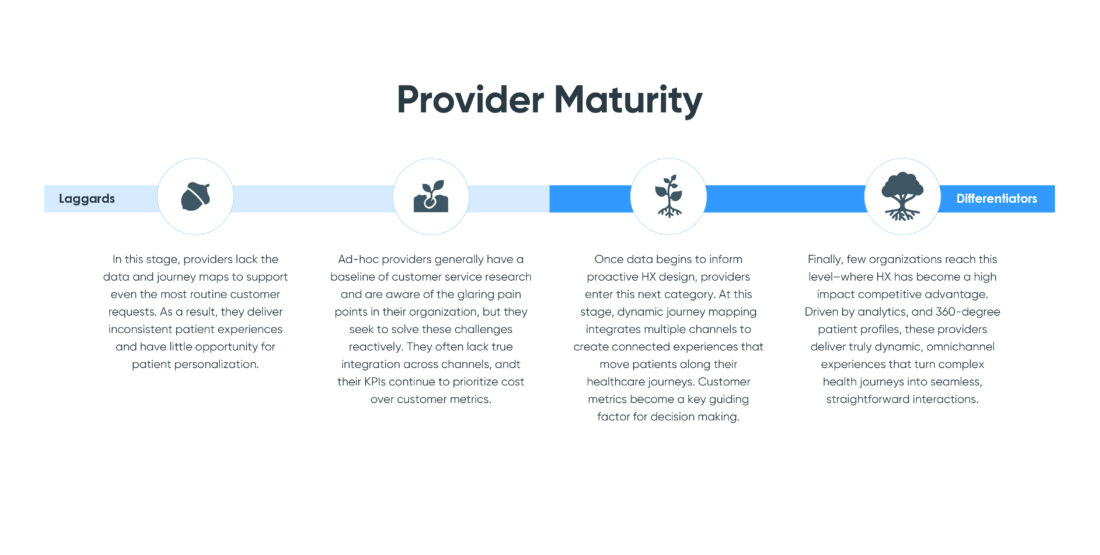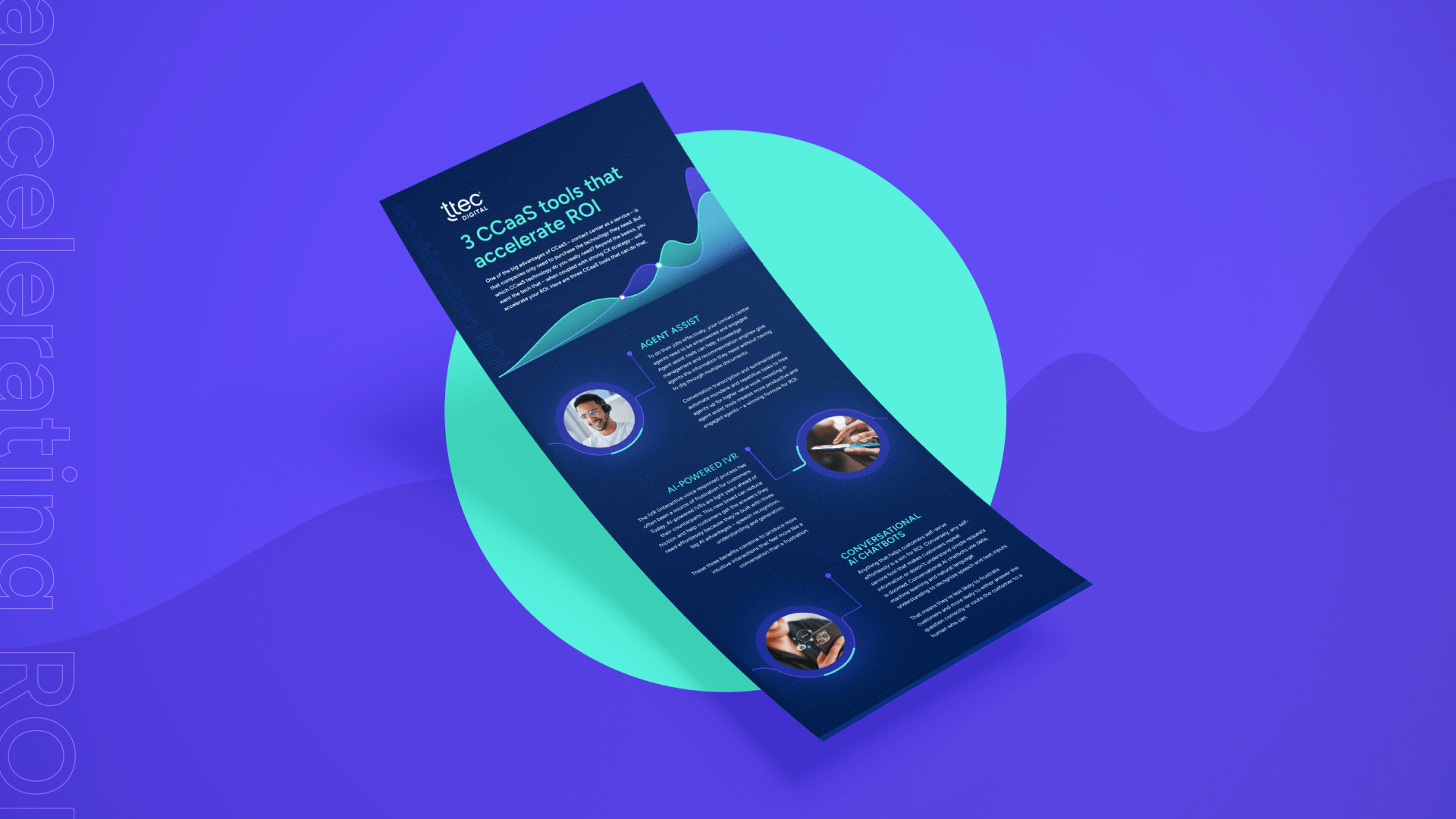What is patient experience?

At its most basic level, patient experience includes all the touchpoints and interactions a patient has with their provider throughout their healthcare journey. These individual interactions coalesce to define a patient’s relationship with their clinician — and even dictate their perception of your organization as a whole.
While patient experience is a popular topic that remains ubiquitous in the modern healthcare conversation, it’s rarely defined. This confusion around what a patient experience means and encompasses can displace its need or importance, or make it seem like an unattainable achievement. However, delivering an exceptional patient experience is quite achievable, and is a necessary priority that can be harnessed and mastered by any healthcare provider today.
In healthcare, there has never been a greater need for a strong patient experience than there is today. The rapid rise of digital-first solutions to support traditional in-person care strategies — combined with an influx of powerful customer experiences available in just about every product category—has created an expectation for seamless omnichannel interactions that prioritize health outcomes and simplify access to care. To succeed in this increasingly digital and highly competitive landscape, providers must now demonstrate that they understand their patient’s needs and can support those needs with the healthcare experiences (HX)—or patient experiences — they require to feel confident and cared for.
“Patient experience is the sum of all interactions, shaped by an organization’s culture, that influences patient perceptions across the continuum of care.”The Beryl Institute
Historically, patients had only a few touchpoints with their providers. They would see their care team in-person during health appointments, interface with support and appointment scheduling staff, or call to get in touch with a clinician to answer their questions.
Over the past decade, however, this relatively limited list of potential healthcare touchpoints has expanded rapidly to include new digital tools and greater communication flexibility than ever before. While these advancements carry significant promise to elevate engagement strategies and maximize care team bandwidth, they also create new opportunities to make or break patient perception of your organization, your culture, and even your competence as a provider.


In the post-pandemic world, and serving patients in what we’re calling healthcare 3.0, more healthcare interactions take place in this emerging digital ecosystem. Of course, each one of these individual interactions — whether it’s online, on the phone, or in person—is only one small part of the overall patient experience. In practice, patient experiences are more commonly judged holistically by the relative ease with which patients can move between these interactions as they progress along their unique health journey.
Why patient experience matters more than ever
For years, patient perception of care quality carried little weight in the way healthcare was administered. Health clinics and hospitals were largely empowered to engage with patients on their own terms — in ways that best meet the needs of their clinician teams, workflows and revenue streams. This wasn’t because providers didn’t care about patient concerns. Rather, treatment reimbursement models were designed to prioritize the volume of procedures completed (fee-for-service model) over health outcomes.
Then, in 2010, this model of care changed drastically with the passage of the Affordable Care Act (ACA), as it set in motion the first value-based care model that rewarded providers for the quality of the care they delivered. Quality in this case was defined as improved patient care, improved population health, lower healthcare costs and increased provider satisfaction.
The final pillar listed here, increased provider satisfaction, has since become a powerful factor in payer reimbursement. Using the Consumer Assessment of Healthcare Providers and Systems (CAHPS) survey and other patient satisfaction metrics as a barometer for the patient experience, healthcare organizations now have the data and incentive to focus on patient-centered care and redesign their experiences to better align with patient expectations.
At the same time, patient expectations are also changing.
88%
Patients who report going online to read reviews and assess potential care options.
In the era of high-deductible health plans, patients have more of their own money at stake than ever before. And with greater awareness to cost comes a greater emphasis on finding new ways to get value from those dollars. This consumerization of the healthcare experience has driven many patients to weigh their options and choose clinicians and providers more strategically than in the past.
Add to the mix a plethora of powerful, frictionless customer experiences surrounding patients at every turn in their day-to-day lives, and it is no surprise that patient expectations are rising. Compared to their last best experience in retail or with a direct-to-consumer brand, patients are demanding more from their providers.
Learn more about how your organization can deliver a great patient experience year-round
Access The Patient Experience RoadmapFor healthcare organizations, the potential cost of a poor experience can have a disastrous effect on already razor-thin provider margins. According to one U.S. Healthcare Consumer Experience Study, 41% of young healthcare consumers reported they would stop going to their healthcare provider if they felt they received a poor digital experience. Even worse, 20% of respondents noted they had already stopped or switched providers for this very reason. In an industry inundated with new players—from new healthcare startups to retail-based health clinics and private urgent care rooms—providers simply can’t afford to fall behind.
What are today's patient experience expectations?
To maintain market share in 2021 and beyond, healthcare providers need to replicate the experiences provided by CX behemoths like Amazon and Google—delivering hyper-relevant experiences to patients across channels. Here are a few key elements patients now expect to see every time they interact with your organization.
1. Transparency and open communication
As the cost burden continues to shift to patient pocketbooks, patients need to know what procedures, appointments and medications will cost them. In the past, patients might not see a cost estimate until the bill showed up weeks later. Now they expect upfront transparent pricing, and readily available pricing support, to help them navigate what they can and can’t afford—and plan their spending and saving appropriately.
2. Self-service opportunities
For years, patients have needed to interface with someone from their provider organization to do just about anything—cancel an appointment, receive medical advice from a clinician or research a claim. This stood in stark contrast to the relatively frictionless self-service experiences they encountered just about everywhere else, where they could cancel and reschedule appointments with a few taps on their smartphone, chat with a rep online about a bill, and so much more. Part of the modern patient expectation is to feel empowered to manage their own care and make it fit into their schedule, rather than the other way around.
3. Personalization
While digital tools introduce flexibility and efficiency to the healthcare ecosystem, they can also sometimes replace many of the in-person interactions that make patients feel most cared for and valued by their clinicians. With this in mind, personalized experiences tailored to patients’ unique care plans can help make them feel like more than just a number—or worse, another revenue source. Additionally, each patient seeks to use new digital tools in different ways. They want to know that their providers are utilizing their data and collecting their preferences to customize how they serve them.
4. Accessible care
In a world where instant gratification customer experiences are everywhere, patients expect that care can be provided right here and right now. Yes, telehealth options are one way to offer more accessible care strategies, but other methods such as interfacing with clinicians via a secure patient portal or providing preliminary appointment information via other digital formats can help reduce the need for long, time-consuming in-person appointments and match patient need with the appropriate level of engagement.
5. Shoppable care
As patients learn how to become more savvy healthcare consumers, it only makes sense that they would start to compare their healthcare options in a similar way. In the retail world, reviews and ratings and shopper experiences play a large role in giving consumers a way to compare services and products. In healthcare, patients increasingly expect the same resources to help them make an informed decision—and providers without these resources risk being dropped for others that do.
Ready to chart your path toward healthcare experience transformation?
Access The Patient Experience RoadmapHow to improve your patient experience
Since COVID-19 disrupted many established patterns of care, most healthcare organizations can say they now check at least some of the digital boxes in a patient’s provider expectations checklist. But these piecemeal executions of next-gen patient experience can’t live in a silo. They require seamless, strategic connectivity to every aspect of your healthcare operation—informed by data-driven insights—to drive truly transformational patient experiences that take your organization from ad-hoc HX strategies to embedded competitive advantages.


In order to move from left to right on this chart toward embedded HX status, organizations should focus on a few key areas of growth.
Embrace a patient-first strategy
Treating patient experience improvements as solely an IT or marketing challenge sells it short and immediately reduces the far-reaching impact it can have on your organization’s ability to drive more powerful experiences for patients at every stage in their healthcare journey—from researching your clinic as a possible care option to managing existing health conditions, to paying for their care. Many of the organizations that have successfully moved from reliable to embedded were able to do so because they have invested in the right strategic leadership to think about the patient experience in the same way that a retail brand thinks about its customer experience. Once you know what experience you want to provide across every channel and every journey, you can use that vision as the North Star for each cascading tactical decision that follows.
Integrate data management systems
Your organization has access to powerful data that can transform patient outcomes. Experts now say the US healthcare system produces one zettabyte of data annually. Yet data siloes often slow down collaboration between care teams and even make patients feel unimportant—or worse, uncared for altogether. Data management systems that enable the creation of 360-degree patient profiles give every patient-facing team in your organization the insights they need to have an impact on health outcomes and impress patients with personalized engagement.
Utilize technology that addresses key pain points
Technology, including innovative digital systems spanning multiple channels, can help your organization meet identified patient needs. Behind the scenes, support staff can use workforce management solutions to track and manage customer interactions. On the front end, patient or relationship management systems can also be used to facilitate frictionless patient experiences via simple user interfaces, streamlined digital interactions and proactive engagement. To start, focus on tools that allow your teams to prioritize many of the patient needs listed in the previous section—including self-service capabilities, virtual care and communication between patients and clinicians.
Track and measure patient and employee feedback
Trying to provide frictionless patient experiences is a moving target. And right now, it’s a fast-moving target too. The only way to stay on top of evolving needs and expectations is to keep listening to what your patients and employees have to say. As a part of this always-listening approach to improvement, it’s important to set up methods to acquire qualitative feedback that empowers your organization to see where things are going right—and where a few small improvements could eliminate emerging pain points.
Want support building a CX improvement roadmap?
Connect with a CX ExpertTwo examples of leading patient experiences
When an organization finally achieves a truly embedded patient experience strategy — what does that look like? While the results will vary based on the unique value propositions each organization seeks to provide, many of the best examples start by seeking solutions to key patient pain points and linking them to critical business initiatives. Let’s take a closer look at two examples of organizations that got it right.
Mary Washington Healthcare: Digital patient experiences driven by data
Mary Washington Healthcare is a large not-for-profit healthcare system with multiple hospitals and more than 50 healthcare facilities and wellness services. To deliver next-gen patient engagement, Mary Washington knew they needed to move away from analog approaches including TV, print, and billboards and capitalize on the power of personalized digital experiences. They also knew they weren’t fully leveraging the wealth of data resources they had at their disposal to target patients with high-risk and chronic conditions and make decisions about the appropriate engagement strategies for each patient.
By partnering with TTEC Digital to help design and orchestrate a modern digital strategy, Mary Washington can unify and enrich disparate data from Epic and other data sources that will allow them to better engage selected patients with solutions that fit their patients’ digital expectations.
DispatchHealth: Reducing visit friction with accessible care
DispatchHealth’s big idea for patient care was simple: not every healthcare condition should require scheduling an in-person appointment or a frantic rush to the emergency room. Particularly, they saw a gap in care for patients with conditions who may face major challenges, or face additional health risks, when trying to come in for an appointment at a clinic or hospital. These in-person visits also incurred higher costs—often beyond what was medically necessary to treat many routine ailments and illnesses. To help remove this major point of friction, DispatchHealth wanted to design a way to make healthcare more mobile.
TTEC Digital helped DispatchHealth stand up a hospital-at-home program where care is delivered in a patient’s home. Now, patients easily request care via a simple mobile or online request portal. On the back end, patient care teams assess each patient’s situation, and a real-time communication platform helps dispatch a qualified care team to treat each medical condition at home. As a result, this new care delivery model is allowing DispatchHealth to save an average of $6200 per patient in unnecessary hospital and clinic costs while creating valuable peace of mind for overburdened patient populations.
How TTEC Digital fuels exceptional patient experiences
As the separation between the healthcare laggards and leaders continues to grow in the post-pandemic world, any healthcare experiences that fall outside of patient expectations run the risk of frustrating patients or even triggering churn. Of course, correcting poor patient experiences requires more than investment in powerful next-gen tools and capabilities. It also requires the implementation of foundational HX strategies to pull the tools together into one interconnected solution.
For nearly 50 years, TTEC Digital has been laser-focused on solving this complex and evolving challenge for healthcare providers. By combining our healthcare industry experience with our cutting-edge, end-to-end design and orchestration services, TTEC Digital is uniquely qualified to both customize and implement innovative HX programs that can help future-proof your organization and empower your teams to respond to the ever-changing healthcare landscape.
TTEC Digital can help your organization:
Understand your changing audience
Patients, members, physicians, families, employees—the average provider organization has many stakeholder viewpoints to consider. Our data collection and data management solutions can help you integrate powerful insights into your HX strategy through cutting-edge data practices, technology expertise and award-winning VOC programs.
Build a digital front door
Digital-first healthcare experiences are the expectation. TTEC Digital can help you respond to the digital mandate by building a digital front door that integrates your website, mobile applications, marketing channels, portal solutions and other digital properties into an omnichannel solution that accounts for patient preferences and helps personalize care.
Ready to start delivering a digital front door to your customers? Here is a toolkit to get you started.
Download the ToolkitImprove your HX maturity
The best experiences aren’t reserved for large corporations with giant budgets. TTEC Digital can work with organizations at all stages of HX maturation to help them level up their experience and capitalize on new opportunities. Plus, we have deep partnerships with companies like Microsoft and Genesys that help us enhance the experience even further.
Drive powerful business value
Patient experience isn’t just about patient preference. When providers turn HX into a strategic, organization-wide initiative it can help lower costs to serve, increase revenue and even improve customer acquisition and retention. Our team is equipped to help your organization select the right business outcomes to target and identify the necessary steps to achieve your goals.
Join our mailing list
Receive exclusive updates on the latest CX trends, events, and solutions.

